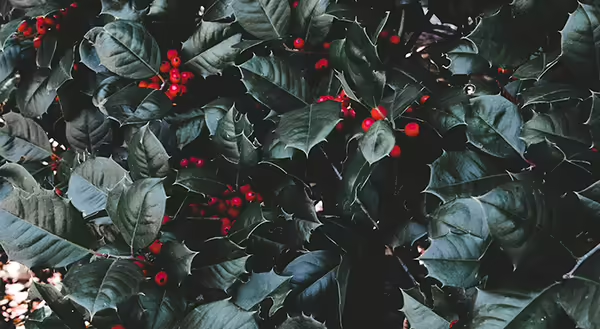
Hollies are common landscape plants and even more common holiday decorations that belong to the incredibly diverse genus Ilex which contains over 400 species, both evergreen and deciduous, that hail from all corners of the globe.
A locally adapted holly species or cultivar is relatively easy to grow and they are fairly disease and insect free. They are incredibly prunable, with dormant buds at the ready to fill in and many do quite well with rejuvenation near ground level if their canopy needs an overall reset.
Growing Holly
Perhaps their biggest weakness in the landscape is overly alkaline soils. As with many other trees and shrubs, they tend to develop iron chlorosis in our typically more alkaline urban soils.
Evergreen species do need a bit of protection in winter, especially in exposed and windy sites here in central Illinois. Drying winter winds are stressful to all broadleaved evergreens and many of the commonly sold hollies are only hardy to Zone 4 or 5 (our area is on the border of Zone 5 and 6). This overall lack of winter hardiness, along with evergreen foliage can be a recipe for disaster if some thought is not spent on their landscape placement.
One of the most common questions in growth of landscape hollies typically lies in their berry production. Hollies are diecious, meaning that male and female flowers are born on separate plants. Therefore, a male plant is needed for pollination in order for female plants to produce berries. The typical recommendation is one male for every three to five female plants, although I have observed this ratio shrunk to include even fewer males.
I’m often asked how close to place male and female plants in the landscape to ensure pollination and I’ve not come across a conclusive, research-based answer for that question. I’ve typically planted hollies in groupings including one male and multiple females, simply because it like the look of these plants in a group.
Using Holly in the Landscape
I’ve often admired hollies as specimen plants in landscape designs by others. In these instances, where individual hollies are more separated in the landscape, common sense and observation of established plants has led me to believe that most plants situated in the same yard, within about 100 feet of each other is sufficiently close.
This distance can likely be extended if landscape arrangement requires further separation since most hollies flower profusely and abundant pollinators have emerged by late spring during flowering. Their easily accessible flower structures tend to attract bees, wasps, flies and even some moth species. Therefore, most landscape settings will host various suitable pollinator species during flower production.
When selecting holly species for the landscape, I tend to lean toward the native species since that is my overall preference in plants. Among our natives, I believe American holly (I. opaca) is an underused and unique landscape plant. It is only native to Union County in southern Illinois, but its is prolific across our southern states and I’ve really enjoyed seeing it on trips southward. It has the quintessential, evergreen holly leaves and bright red berries and matures into a small tree-sized plant at about 20-30 ft in height.
My favorite native is winterberry (I. verticillata) which is actually a deciduous species. In the absence of winter foliage, it hosts a spectacular display of bright red berries that persist in good condition for most of winter. While birds do eat the berries, they are not a preferred food source, which is one of the reasons they persist. However, this plant can be an important emergency food supply in the late winter since it can be one of few species to hold berries.
Among the non-natives, I’ve really enjoyed the Meserve hybrid hollies (I. x meserveae), produced by amateur horticulturist, Kathleen K. Meserve in the 1950’s. She created these cold-hardy hybrids by crossing English holly (Ilex aquifolium, Zone 7) with prostrate holly (I. rugosa, Zone 3). They represent the most commonly available commercial hollies to this day and feature dark green foliage on blue-purple stems with abundant, deep red berries on female plants. They typically remain in shrub form, rarely exceeding 15 feet in height.
As you observe gaps in the landscape this winter, consider adding one of these attractive hollies. For more information on locally adapted species and cultivars, check out the Holly Society of America website.